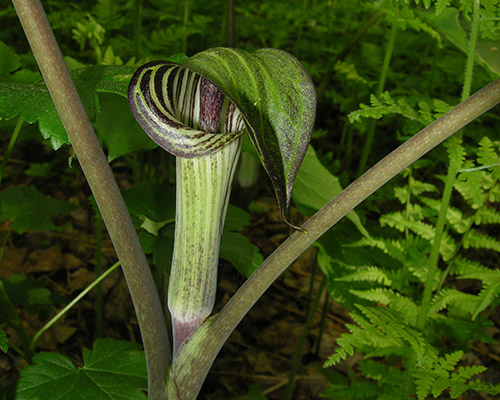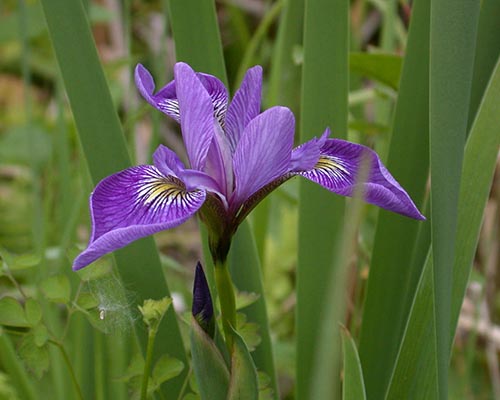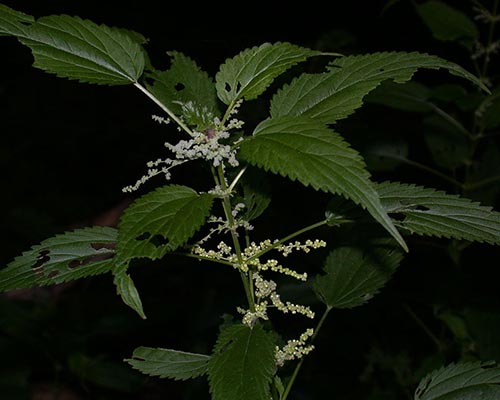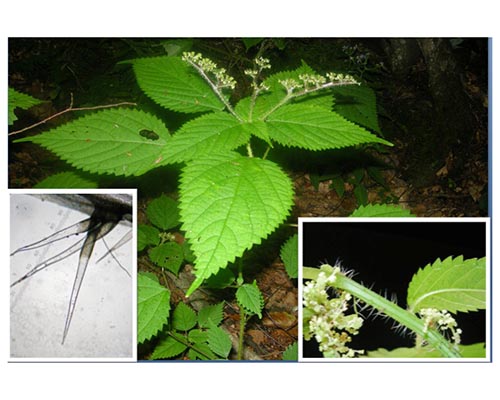The Aquatic Life station discussed plants and animals that inhabit the water. Here, we focus on plants that live in wet areas, but not in the water.
Jack-in-the-pulpit or bog onion (Arisaema triphyllum) is a perennial found in moist woodland areas. It grows from a corm, a storage organ like a tuber or bulb. As the name bog onion suggests, its corm is edible. However, it contains needle-like crystals of calcium oxalate that will cause painful irritation of the mouth and throat; thorough drying and cooking is needed. In any case, moderation in one’s enthusiasm for the bog onion is required.
Jack-in-the-pulpit flowers from April to June. Its flowers smell like mushrooms to attract the fly that pollinates them. It has unisexual flowers, producing separate male and female flowers. Most plant species with separate male and female flowers are monoecious, with male and female flowers occurring on the same plant, or dioecious, with a given plant producing exclusively male or female flowers. Jack-in-the-pulpit has its own system. Small, young plants produce mostly or exclusively male flowers, but as the plants age and grow, they produce progressively more female flowers, thus changing sex as they grow. This inhibits self-pollination and inbreeding and places the burden of producing energy-rich fruits and seeds on more mature individuals — “Jill” instead of “Jack,” a logical innovation.
Blue flag iris (Iris versicolor) is also a wetland perennial, found in marshes, swamps, roadside ditches and on the banks of ponds and streams. It tends to occur in clonal colonies connected by rhizomes. It is quite poisonous. Indeed, simply touching the rhizome or leaves can cause dermatitis. The blue flag flowers from May to July, and is the provincial flower of Québec.
Stinging nettle (Urtica dioica) is another wetland perennial. It is often found as an understory plant in wet environments, but can also be found in fields, meadows and along roadsides. The common name stinging nettle might warn you that this plant is unpleasant. In fact, its genus name, Urtica, does as well; it comes from the Latin verb “to burn,” and the medical term for hives is “urticarial.” The stinging nettle has tiny hairs called trichomes on its leaves and stem that deliver a powerful stinging sensation with even the slightest touch or brush. These trichomes are actually like tiny hypodermic needles. They are hollow and inject chemicals that can cause pain and irritation for several hours. The chemicals injected are a laundry list of nastiness, including inflammation-causing chemicals such as histamine and leukotrienes, neurotransmitters such as acetylcholine and serotonin and perhaps even formic acid, the same chemical that many ant species use in their painful bites. If you have a bad encounter with stinging nettle, antihistamines, hydrocortisone or calamine lotion might be helpful.
Despite this unpleasantness, stinging nettle has a long history of medicinal use for arthritis and various other ailments. It is also edible when young, with a spinach-like taste. Soaking or cooking it removes its noxious chemicals. An herbal tea is often made from its dried leaves and flowers, and nettle beer is often made in the British Isles. Nettle stems contain strong fibers that have been used to make clothing for several thousand years.
The caterpillars of various butterflies and moths also manage to find use for the stinging nettle, eating its leaves while navigating around its stinging trichomes. One such butterfly species found in the Adirondacks is the red admiral (Vanessa atalanta).





.jpg)